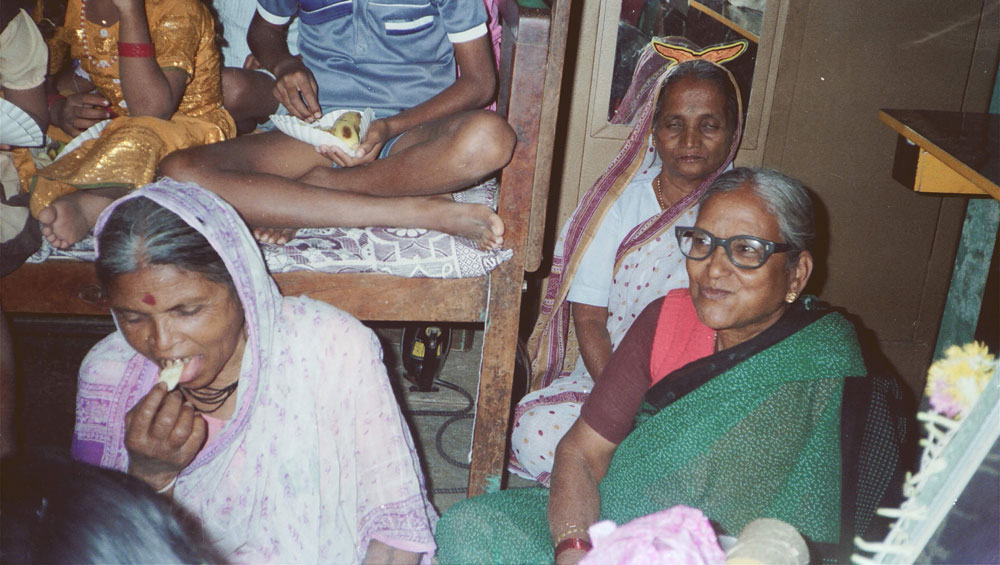
by ROSANNA MCLAUGHLIN
It is raining when I interview Rajyashri Goody. Not just any rain: Mumbai monsoon rain. Five minutes before pressing the record button on my phone, the city skyline glistens across the bay, visible through the windows of the ninth-floor apartment in which we are sitting. By the time we begin our conversation, the view is obscured by a wall of water that sends the hawks in search of shelter and turns the streets below into a temporary network of miniature lakes.
Our conversation takes place in the apartment of a mutual friend, five days after Goody’s first solo exhibition, Eat With Great Delight, opens at Clark House Initiative in the Colaba district of south Mumbai. The exhibition contains 10 framed photographs of Goody’s family, taken from the 1980s to the 2000s – images of relatives coming together to celebrate over food, at weddings, birthdays, or simply to mark the occasion of a visit – and a booklet of “recipes” compiled from extracts of Dalit literature.
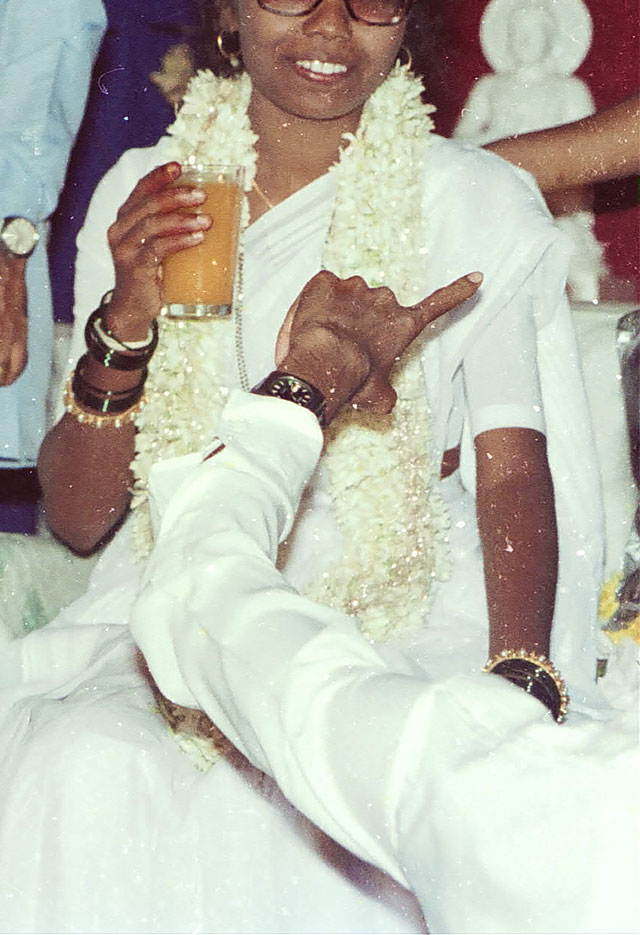
Rajyashri Goody. Untitled, part of the series Eat With Great Delight, 2018. © the artist.
Goody, 28, lives with her family in Ambedkar Colony, a Dalit community in the city of Pune. In person, she is warm and eloquent, with a systematic way of talking that betrays her training: she has a BA in sociology from the University of Pune (2008-11) and an MA in visual anthropology from the University of Manchester (2012-13). As well as using her work to raise awareness of the extraordinary cruelty Dalit people have faced (and continue to face) at the hands of the Hindu caste system, Goody believes a nuanced reflection on Dalit experience is needed: one that also accounts for, and introduces new audiences to, a rich cultural history. Of particular interest to her is the highly evocative lineage of Dalit literature, and the significant and complex relationship with food among a people historically denied it.
Clark House Initiative, where the exhibition takes place, is one of only a handful of spaces in India that actively supports the work of Dalit artists. Earlier this year, Goody travelled to the Showroom in London with a number of members of Clark House Initiative to participate in the exhibition Working Practices.

Rajyashri Goody. Eat With Great Delight, installation view, Clark House Initiative, Mumbai, 2018.
Rosanna Mclaughlin: Shall we begin by discussing Eat With Great Delight, your current exhibition of photographs at Clark House in Mumbai?
Rajyashri Goody: The exhibition mainly consists of photographs of my family celebrating with food, as well as extracts from Dalit literature that relate to the experience of accessing food, which I have turned into recipes. I’m interested in food and caste, specifically Dalit food politics. Numerically speaking, Scheduled Caste and Scheduled Tribe communities comprise 25% of the country’s population. Still, their narratives get wiped out in favour of the larger, stereotypical Indian narrative, and I wanted to address this in this exhibition by showing a record of Dalit life within my own family as well as through Dalit literature.
RM: By the “larger Indian narrative”, do you mean a propensity to conflate India with Hinduism?
RG: Wherever you are in the world, the people with the most power get to control the narratives about situations of which they are only a part. In terms of food, for example, this can manifest as something as simple as a cookbook of Indian recipes. Most people outside India have this assumption that Indians are vegetarian, because Indian cookbooks hardly ever contain recipes with meat in them. If they do, it will be chicken or mutton: beef and pork are typically erased. So, because Brahmins are vegetarian, and Brahmins are the most powerful caste who have had the most access to literacy and “knowledge”, India comes to be seen as a vegetarian country, despite the fact that Brahmins are not the majority.
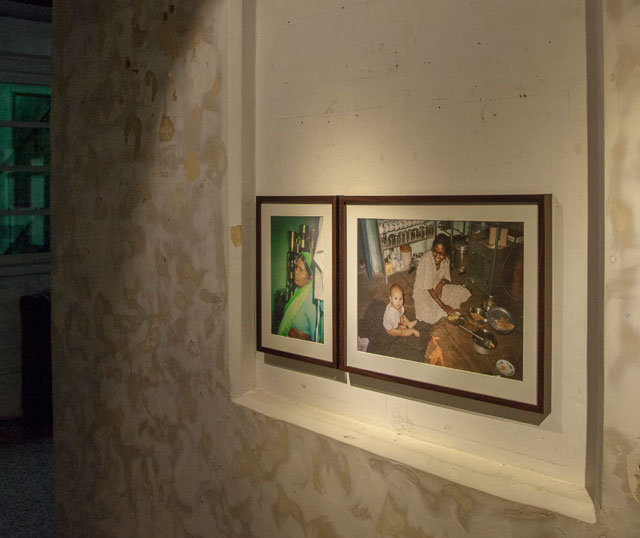
Rajyashri Goody. Eat With Great Delight, installation view, Clark House Initiative, Mumbai, 2018.
RM: The photographs were mainly taken by your parents – some on visits to the UK, but mostly in your family home in Pune. Can you tell me about where you grew up?
RG: My mum is Dalit and my dad is English. We live in Ambedkar Colony in Pune, which is where my mum has lived ever since she was a little child. My dad converted to Buddhism in England, moved to Pune in 1974, and consequently began working with the Ambedkarite neo-Buddhist movement. That’s where my parents met. BR Ambedkar was a Dalit who converted to Buddhism in 1956. He was a lawyer and he wrote the Indian constitution and worked towards the annihilation of the caste system. At every stage of his life, even though I believe he was one of the most intelligent people in the world, he faced caste issues, such as people not wanting to eat next to him or share an office space with him. My dad is a social worker – he fundraises to help set up hostels and educational institutions for Dalit kids and activists. My mum used to be a lecturer in banking and commerce, and now helps to run a girls’ hostel as well as an activism centre in Pune.
Ambedkar Colony in Pune is a housing colony mainly filled with Dalit Buddhists, people who converted to Buddhism in the 1950s and 60s or later. Hundreds of people live there. You’ll find Ambedkar colonies in many cities across India.
RM: Is the conversion of Dalits to Buddhism an attempt at extrication from the Hindu caste system?
RG: It came from a strong feeling that there’s no way to get rid of caste within Hinduism. There is also a theory that early Buddhists were made untouchable by Hindus as well, so there is an element of going back through history in search of solidarity. Dalits have also converted to other religions, such as Christianity, Islam, or Sikhism, but there has been a major revival of Buddhism in the country with hundreds of thousands of Dalits converting to the religion every year since 1956.
The Ambedkar Colony in Pune is where I grew up, but I went to a middle-class English-medium school [a school where students primarily learn in English when it is not their mother tongue] where I met no other Dalits. There were kids from all sorts of religions, but caste was never spoken about. It was a weird up and down experience for me: at school, there would be no discussion of caste discrimination, but at home we would have conversations about it all the time. I was not personally discriminated against during my education – perhaps because of my white father – but discrimination was definitely a conversation that my aunts, my mum, and the whole society I grew up in, was having.
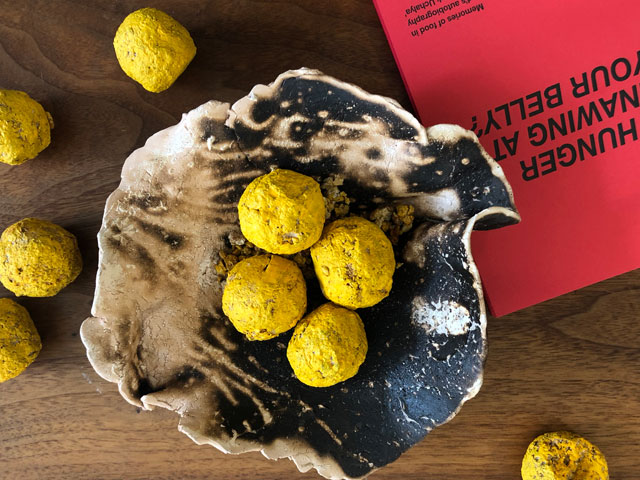
Rajyashri Goody. Manu Laddoos, 2018. © the artist.
RM: Your photographs are filled with celebratory scenes of people coming together. You have spoken before about the need for positive images of Dalit life to enter into circulation.
RG: First of all, the problem is that there is not enough representation of Dalit people. Second, the representation that does exist is occupied with trying to show the issues people face – and for good reason. My dad and his colleagues, for instance, photographed people working in their caste-prescribed jobs, such as manual scavenging, in order to show others how terrible it is and to try to raise money to help. They also photographed Dalit communities enjoying themselves, and meditating. Hard-hitting images that reflect the violence of caste are obviously extremely important to take, but if you don’t have any positive imagery you only disseminate a narrative of victimhood.
For this exhibition, I specifically chose to represent my family. We’ve been very lucky – there has been a lot of struggle, but I’m able to say that my family has had a good life. I’m sure that is true for a lot of Dalit families, although I certainly don’t want to elect myself as a representative.
RM: When were the photographs in the exhibition taken?
RG: Except perhaps for a few studio shots of my grandparents, we don’t have many photographs before my parents’ wedding in 1984. That’s when my family first got a point-and-shoot camera. I am interested in what changes when you are in possession of a tool to record yourself, and how much that can help with producing and disseminating memories and, consequently, history. Since my family got the camera, we’ve been able to document our history. Before that, it’s almost as if we didn’t exist. Access to the simple things makes such a difference in how your history is told. Access to reading and writing means you can write your own books, even if they’re just cookbooks, and access to a camera means that you can show your story, dictate the terms of your visual representation.
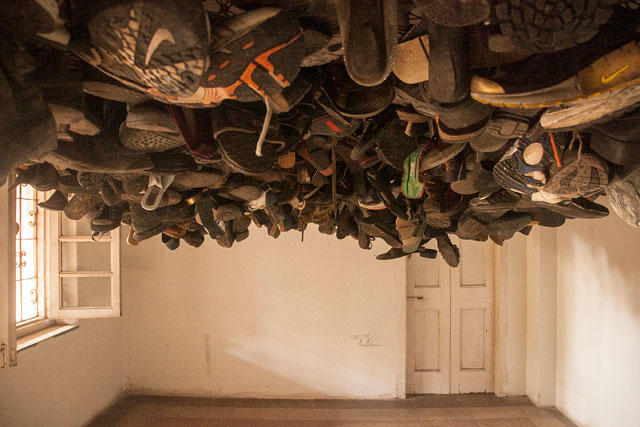
Rajyashri Goody. Skyscape, 2015. © the artist.
RM: Let’s talk about the recipes you make from Dalit literature, and which you compile into booklets that you then give away. These booklets feature in Eat With Great Delight; you also included them in the group exhibition Working Practices, at the Showroom in London earlier this year.
RG: I try to disseminate them everywhere I can. The recipes are each a single extract from Dalit literature where the writer is describing their experience of consuming food, or perhaps even hunger, and they range from three lines of the original text to a couple of pages. I break up these extracts into short lines that almost sound like instructions, and change the tone of the lines from first person to second person, fitting into the conventional understanding of how a recipe works. Of course, most of these recipes can’t be followed, and that’s the point: one can’t replicate the Dalit experience of eating, or not eating as the case may be.
Dalit people have a very, very complex relationship with food, which people of an upper class or caste don’t experience. This could manifest as enjoying your food, but also knowing that access to it might be difficult on a daily basis, or enjoying your food, but that enjoyment also being layered with shame, because the food you are eating, such as beef or pork, is not seen as pure. Or it could be not enjoying your food and just eating what you have to eat to survive. Consuming beef is banned in many parts of India, and there have been a growing number of lynchings, particularly of Dalits suspected of transporting or eating beef, by self-appointed “cow protectors”. In May and June this year alone, there have been 16 lynching incidents, taking the lives of 22 people.
One’s caste-occupation can sometimes directly correspond to one’s eating habits. For example, those who work on other people’s farms getting the final, sometimes smallest, share of the crop, or manual scavengers eating the meat from the cow carcasses their caste-occupation demands they get rid of. There are also specific rules laid out in the Hindu law book, the Manusmriti, such as not allowing inter-caste dining. Of course, this isn’t the case with all Dalit communities, but, historically, a majority of people’s experiences have been coloured by these kinds of experiences. Many recipe books also tend to romanticise and exoticise cultures, which would be uncomfortable in this context given the history of restricted access to food among Dalits.
As well as bringing these histories to life, I also want to draw attention to how amazing Dalit writing is. By placing these recipes in the spaces I exhibit, I intend to highlight and credit the Dalit writers I have been inspired by and extend the audience for their work. So, yes, we’re talking about recipes, but we are also talking about the incredible ways Dalit people have been able to express themselves since access to education was made relatively easier.
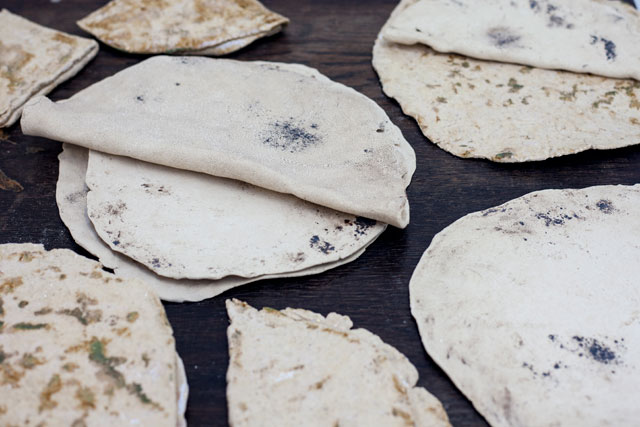
Rajyashri Goody. Bhaakar, 2017. © the artist.
RM: The first time I encountered your recipes I was surprised by how different they are from conventional recipes. Rather than instructions for how to cook, they are testimonies of the conditions under which Dalit people source and eat food. It made me realise the ways in which recipes always portray the socio-economic status of both the author and the reader, even if this is something that is rarely acknowledged.
RG: With a typical recipe book, you assume a lot of things. You assume that the reader has a kitchen, you assume that all the ingredients are accessible, you assume that the person looking at the book can read. The caste system is distinctly violent in the way it has repressed access to education, and being able to read and write is the key way in which your narrative travels and your stories are shared. The format of the cookbook, therefore, relates to two fundamental aspects of life denied to Dalit people: literacy and food.
The process of opening up schooling to Dalits began in 1850 with the signing of the Caste Disabilities Removal Act, and more efforts have been made since the constitution of independent India was written and the practice of “untouchability” was abolished. I will say, however, that, despite the fact that there are now laws in place directing educational institutions across India to reserve a certain number of places for Dalit students, many Dalit communities still face major hurdles when accessing education. In the case of primary schooling, since many children are first-generation learners with limited finances, the only available options are government schools. In rural areas in particular, there is widespread discrimination in these schools towards students from Dalit and other marginalised backgrounds. In some cases, for instance, they are made to sit separately or clean the toilets. In the case of higher education, there is little institutional support for Dalit students, who often feel alienated. In January 2016, Rohith Vemula, a research scholar at the University of Hyderabad, killed himself after his fellowship was withdrawn and he was ostracised from the university community because of his political activity. I, like many others, believe this amounted to institutional murder.
.jpg)
Rajyashri Goody. Manu, 2017. © the artist.
RM: In the recipe Milo Gruel, which featured in the booklet you produced for Eat With Great Delight, you use an extract from the book The Branded: Uchalya (1999) by Laxman Gaikwad. It’s a beautiful passage, that contains the joy of eating as well as the bleak social stratification that restricts access to food.
RG: In this extract, the writer is talking about how, as a boy, his family would get milo from the farmer, who would give them the shitty bit of the crop, which they would then cook unclean. I find it interesting how he describes the crop as being full of worms and insects, but also how much he loves eating it, how greedy he is, wanting more and more and more – then feeling the brunt of his brothers’ anger at having to give this child more food. They call him “a curse”.
RM: There is a specific vocabulary that relates to caste-based food practices that comes up in your work. For instance, in the text you wrote to accompany your exhibition at Clark House, you refer to “joothan”. Can you describe what this means?
RG: Until recently, I thought joothan just meant leftovers, but I realised while reading the Dalit writer Omprakash Valmiki’s autobiography, Joothan: An Untouchable’s Life (2003), that it actually describes a caste-based practice. It refers specifically to leftovers from a plate, scraps of food that would usually go into the dustbin. Valmiki writes about his family waiting outside upper-caste weddings with large baskets for the hosts to dump their leaf plates in, and then taking those plates back home and preserving the scrap food: for example taking bits of pooris and drying them, so that they could be used for six more months. The leftovers from other people’s weddings can be made to last for months.

Rajyashri Goody. Eat With Great Delight, installation view, Clark House Initiative, Mumbai, 2018.
RM: Joothan is highly symbolic of social division: one caste’s public demonstration of excess demonstrates the enforced frugality of another.
RG: The caste system controls and keeps castes separate. One of the most effective ways of doing this is through pressure to marry solely within your caste, and through food. The practice of untouchability meant that many Dalits couldn’t own their own land, and therefore own food. Instead, they had to work on other farmers’ lands and wait for the village or the farmer to give them a share of the produce. “Baluta” is the term for when a village gives someone their share of crops instead of monetary remuneration. It’s not uncommon for this share to be the leftovers, perhaps filled with insects and that kind of thing – the rubbish bit of the crop, such as that which Gaikwad describes in The Branded, and consequently appears in my recipe Milo Gruel.
RM: Are there many Dalit cookbooks in circulation today?
RG: As far as I know, there wasn’t a Dalit cookbook in existence before a few years ago – a direct result of the ways in which one’s caste determines access to literacy. As with my recipes, the cookbooks that have begun to be published recently are not culinary lifestyle guides, as cookbooks often are: they do the work of connecting food and memory and the experience of discrimination. A good example is Anna He Apoorna Bramha (2016) by Shahu Patole. The title loosely translates as “Our plate has always been incomplete”.

Rajyashri Goody. Eat With Great Delight, installation view, Clark House Initiative, Mumbai, 2018.
RM: Your recipe booklets were also shown at Working Practices.
RG: Working Practices was a coming together of more than 25 artists, most of whom were Dalit, as well as others from Egypt, Senegal, Mauritania, the UK and the US. It was collectively organised by Clark House Initiative, a Mumbai-based union of artists. The exhibition was an attempt to tie together discourses on blackness and caste. There is a longstanding connection between the two, owing to Ambedkar’s interest in the possible solidarities between those discriminated against owing to race and caste. I was keen on sharing my recipes in this context because I have found there to be many parallels between Dalit and black foodways – a subject I researched for two months earlier this year, while on a visiting artist fellowship at Harvard, at its South Asia Institute. As with the caste system, mobility, access and control of food resources was seen as an effective way to enforce power over black communities, whether in the time of slavery or the Jim Crow era.
I’ve been spending time with Clark House members over the past year, and have great respect for the work they do. As a union, they provide residencies and exhibiting opportunities for Dalit artists and others from marginalised sections of society. It is still remarkably difficult for Dalit artists to exhibit their work in India – let alone the rest of the world – where only a handful of galleries have ever shown work by Dalit artists. It felt fitting that Eat With Great Delight, my first solo show, should take place in a space that is open and proud of its Dalit identity.
RM: In addition to your recipe booklets, at the Showroom you also displayed a number of ceramic objects based on foodstuffs, including bhakris.
RG: Bhaakars, or bhakris, are rotis made from millet. They are hardier and heavier than wheat chapatis. Millet is cheaper – it is more like a farmer’s food and is commonly eaten in Maharashtrian villages. I grew up hating them because I found them so bitter-tasting and not as soft or delicate as chapatis. But when I started reading more Dalit literature, I noticed how the bhaakar was talked about and treated with such care and respect. For example, in Sharankumar Limbale’s book The Outcaste (2003), he writes that the bhaakar “is as vast as the sky, and bright like the sun”. I love how something so simple has been put on an altar. It’s as if the bhaakar had these two modes: an intense symbol of survival and resistance, and a kind of whatever-food that not many privileged people respect – including me, until a few years ago. When I started making them, some people laughed a lot. My family were like: “Why would you want to make something like that?” Perhaps they had a feeling that my art should be a little more delicate, or precious.
RM: You also exhibited some paper laddoos, which are Indian sweets.
RG: Laddoos are usually given at a celebration, such as a wedding. I made my laddoos out of the Manusmriti, which was written sometime between the third century BC and the second century AD. Since 1929, Dalit activists have been burning the Manusmriti every year as a symbol of rejecting what it contains, parts of which are pretty horrific. It lays out all the laws relating to caste, including not allowing Dalit people to read and write, and filling Shudras’ ears with molten lead if they intentionally hear the Veda. Even though these ideas may sound ridiculous now, there are many highly religious people – even some academics – who view the Manusmriti as their constitution, rather than the real constitution of India as written by Ambedkar.
I was interested in looking at the ways in which a book as powerful as the Manusmriti is also so physically fragile. To begin with, to remove that power, I started pulping its pages and making plain sheets of paper out of it, to show that this text that has brought so much horror and pain to people for thousands of years is also just paper.
RM: Was the symbolism of making it into a blank sheet one of starting over?
RG: Yes, and also hope, and having the strength to laugh at the Manusmriti, to laugh the evil away. Of course, as a person of Dalit heritage who hasn’t directly experienced caste-based discrimination, this is relatively easy for me to do, but I find that people often access art better when there is humour involved – creating plain pages out of the Manusmriti, or making laddoos out of it that look good enough to eat, and then realising what they’re made of, and thinking through this idea of consuming them and then passing them out of your system.
RM: You came to art through an unusual route, studying sociology and anthropology. How did you make the crossover?
RG: I moved back to Pune after my master’s, and I started working with the artist Shraddha Borawake. She wanted to shake things up in the city by organising a platform, called The Good Artist, for artists working in multiple disciplines to come together. We ended up organising a two-week workshop in conjunction with the Delhi-based arts initiative Khoj in March 2015, at a space called TIFA Working Studios in Pune. The idea was that the people organising the workshop also had to exhibit art alongside the 15 artists we invited to participate. This was my first experience of creating and exhibiting an artwork, and after I got over the initial panic about what I was going to make, I created Skyscape, a large installation on the ceiling of the gallery made from more than 300 pairs of shoes.
The idea for Skyscape came from an ancient diagram of how the caste system is depicted and divided – based on the body of Purusha, the cosmic man – that is referred to in certain Hindu texts including the Manusmriti. The diagram attributes each caste to a different part of Purusha’s body, with the Brahmins at the top as the head. The feet are the Shudras, who were also very poorly treated and who were described as the servant class. Dalit people are below Purusha’s feet. Their status in the diagram is beneath human beings: they are not even considered a part of humanity. This body diagram translates to many aspects of Indian life. For instance, it governs the way an Indian village is divided: the upper castes live right in the centre and the Dalit people live outside the village – they can’t even use the same wells. This is still the case in many villages across the country.
RM: Where did the title Skyscape come from?
RG: I called the installation Skyscape because when one stood inside the room it was impossible to see the ceiling above, the “sky”. All you could see were shoes. It was quite a heavy piece of work, literally and metaphorically – a visual interpretation of the hurdles that Dalit communities still face in the push for equal access and opportunities. It helped me to have some very significant conversations and exchanges with those who came to see the open studios, including with my mum. When she looked at the work, she started laughing. It was a bunch of shoes representing the caste system, and she found it so funny.
• Rajyashri Goody: Eat With Great Delight, curated by Rosanna Mclaughlin and Skye Arundhati Thomas, is at Clark House Initiative until 6 August 2018.